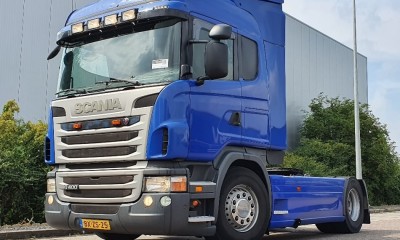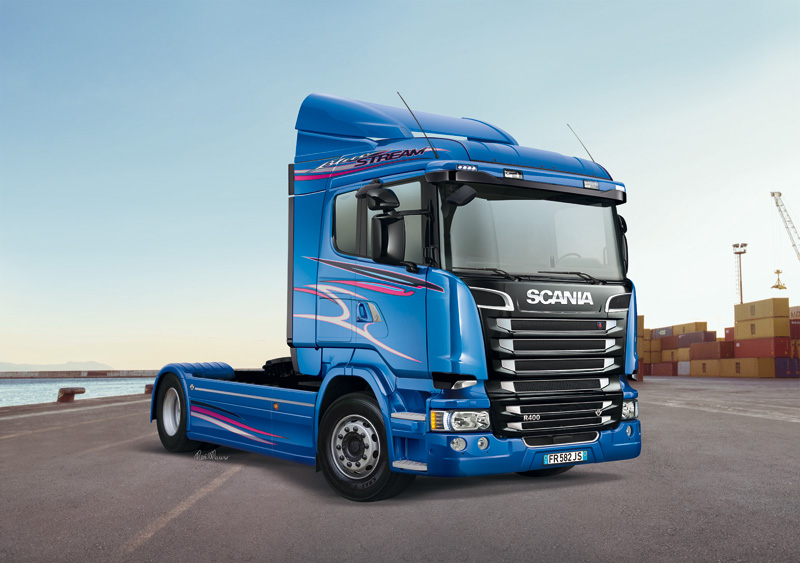Scania R400 Specs & In-Depth Tuning Guide: Unleash Its True Potential

The Scania R400 is more than just a truck; it is a foundational asset in the world of regional and long-haul logistics. Renowned for its exceptional reliability, operational economy, and driver comfort, the R400 has solidified its position as a fleet workhorse across Europe and beyond. Engineered for versatility, it tackles a wide array of transport challenges, from standard haulage to specialized heavy-duty applications. This adaptability is a core part of its design philosophy, setting the stage for how targeted performance enhancements can elevate its inherent strengths to a new level.
Decoding the R400 Model Variants
Scania's modular approach means the R400 is available in a multitude of configurations to suit specific operational needs. The most common is the 4x2 tractor unit, ideal for general freight, but the platform extends to 6x2 configurations with a mid-lift axle for optimized weight distribution, and even robust 6x4 and 8x4 chassis for construction and heavy-haulage roles. 
Driver environment is another key aspect, with several cab options available:
-
R-series Normal Cab: A versatile day or sleeper cab.
-
Highline Cab: Offers increased headroom and storage, making it a popular choice for long-distance routes.
-
Topline Cab: The premium option, providing maximum space and comfort for drivers who spend extended periods on the road.
Core Specifications Across Generations
While the "R400" designation remained consistent for several years, the underlying technology evolved to meet changing emissions standards. Understanding these differences is crucial for any workshop or fleet manager. The transition from Euro 4 to Euro 5 standards marked a significant shift in engine management and after-treatment systems.
|
Parameter |
Scania R400 (Euro 4) |
Scania R400 (Euro 5) |
|
Engine Model |
DC12 / Early DC13 |
DC13 |
|
Displacement |
~11.7 L / 12.7 L |
12.7 L |
|
Horsepower |
400 HP |
400 HP |
|
Power |
294 kW |
294 kW |
|
Max Torque |
1900 Nm - 2100 Nm |
2100 Nm |
|
Emission Standard |
Euro IV |
Euro V |
|
Typical Axle Config. |
4x2 |
4x2 / 6x2 |
|
Transmission |
Scania Opticruise (AMT) |
Scania Opticruise (AMT) |
Data compiled from sources:
A careful analysis of the R400's evolution reveals a key characteristic of Scania's engineering strategy. Despite the introduction of more complex emission control technologies between the Euro 4 and Euro 5 generations, the power and torque output for the R400 model was deliberately kept at a consistent 400 HP and 2100 Nm. This consistency suggests that the engine's mechanical capabilities are not the limiting factor. Instead, the performance is precisely calibrated by the Engine Control Unit (ECU) to fit a specific market segment. This points to a significant reserve of untapped potential within the hardware, accessible through professional ECU remapping.
Powertrain Deep Dive: The Engineering Behind the R400's Reliability
At the core of the R400's reputation is a powertrain built for durability and efficiency. Scania's inline 6-cylinder engines are legendary in the industry, and the units powering the R400 are prime examples of this robust engineering philosophy.
The Heart of the Matter: Scania's DC12 and DC13 Engines
The R400 has been powered by two main engine variants from Scania's highly respected engine family:
-
Scania DC12: Found in many earlier Euro 4 models, this engine features a displacement of 11.7 litres, a bore of 127 mm, and a stroke of 154 mm. It is a direct-injection, turbocharged, and liquid-cooled 6-cylinder inline diesel engine known for its solid, dependable performance.
-
Scania DC13: This engine became the standard for Euro 5 R400 models and subsequent generations. With an increased displacement of 12.7 litres (130 mm bore x 160 mm stroke), it is built on a strength-optimized cylinder block with wet cylinder liners and individual 4-valve cylinder heads. This design not only enhances performance but also promotes easier serviceability and repair, a critical factor in reducing fleet downtime.
A Critical Evolution: PDE vs. XPI Fuel Injection Systems
The method of fuel delivery is a pivotal factor in an engine's performance, efficiency, and tunability. The R400's production life spans a major technological shift in Scania's fuel systems.
-
PDE (Pumpe-Düse-Einheit) / Unit Injector: Common in Euro 4 models, this is a robust and reliable system where each cylinder has its own integrated high-pressure pump and injector. While electronically controlled, the injection pressure is inherently linked to the engine's camshaft speed.
-
XPI (Extra High Pressure Injection) / Common Rail: This more advanced system, co-developed with Cummins, represents a significant leap forward. It utilizes a high-pressure pump to maintain immense pressure (up to 2400 bar, or over 35,000 PSI) in a shared fuel rail. This allows the ECU to control injection timing and pressure with extreme precision, independent of engine speed. The ability to perform multiple injections per combustion cycle is key to improving efficiency, reducing emissions, and enabling finer control during the tuning process.
Scania's Modular Engine Philosophy: The Secret to Tunability
The most compelling argument for tuning the Scania R400 lies in the manufacturer's own design and production strategy. Scania engineers its engine platforms to be highly modular, using the same fundamental hardware—cylinder block, crankshaft, pistons, and often turbochargers—across a wide spectrum of power outputs.
For example, the same robust DC13 engine platform that is calibrated to produce 400 HP in the R400 is also used to produce 440 HP, 450 HP, and even higher outputs in other models within the Scania range. The primary difference between these models is not mechanical, but digital. The performance is defined by the software maps loaded onto the ECU.
This means that a Stage 1 ECU remap for an R400 is not an exercise in pushing the hardware beyond its design limits. Rather, it is a process of recalibrating the engine to safely unlock the performance potential that Scania engineered into the platform from the very beginning. It effectively elevates the R400's performance to that of its more powerful, and more expensive, stablemates, using the very same reliable hardware.
The Control Center: A Guide to the Scania Engine Management System (EMS)
The Engine Management System (EMS), or ECU, is the sophisticated electronic brain governing every aspect of the R400's powertrain. It continuously analyzes data from dozens of sensors to control fuel injection timing and duration, rail pressure, turbocharger boost, and the operation of emissions control systems like Selective Catalytic Reduction (SCR). For a professional tuner, understanding the specific ECU is the first step to unlocking the vehicle's potential.
Identifying Your ECU: EMS S6, S7, and S8
The Scania R400 can be equipped with several generations of Scania's EMS, typically correlating with the engine type and emission standard:
-
Motorola EMS S6: Generally found on Euro 4 trucks equipped with DC11, DC12, and early DC13 engines. It is a capable unit that manages the PDE fuel system.
-
Motorola EMS S7: A common ECU for Euro 5 models, controlling DC09, DC13, and DC16 engines. It features more advanced processing to handle the more complex emissions systems of its era.
-
Continental EMS S8: This is the most advanced and common ECU found in later-model Euro 5 and Euro 6 R400s. It uses a powerful NXP MPC5566 processor to manage the sophisticated XPI common rail system and its associated after-treatment technologies with greater precision.
The progression from EMS S6 to S8 reflects the increasing computational power needed to meet stricter emissions regulations while optimizing performance. This added complexity, however, provides a distinct advantage for expert tuners. The advanced control offered by the EMS S8 over a wider range of parameters allows for more nuanced and effective software recalibration, leading to superior results in both power and fuel economy.
Professional Tuning Methods: OBD vs. Bench Mode
Interfacing with these ECUs requires professional tools and knowledge. At HP Chiptuningfiles, we utilize the most stable and reliable methods for our B2B partners:
-
OBD (On-Board Diagnostics): This method involves connecting to the truck's diagnostic port. While convenient, it can sometimes be limited by vehicle-side security gateways (coordinators).
-
Bench Mode: This is the preferred professional standard for Scania EMS ECUs. The ECU is removed from the vehicle and connected to directly on a workbench. This method allows for a full, stable, and safe read and write of the ECU's software without the need to open the unit's casing. It bypasses any vehicle security and ensures a perfect data transfer, which is critical for reliable tuning.
The Definitive R400 Tuning Guide: Unlocking Performance & Efficiency
A professional Stage 1 ECU remap is a software-only upgrade that optimizes the engine's operating parameters. By carefully modifying the maps within the ECU, it is possible to significantly enhance the Scania R400's power, torque, and fuel efficiency, all while operating within the safe mechanical limits of the stock hardware. No physical modifications to the engine or exhaust are required.
The Results: Quantifiable Performance Gains for the R400
A custom Stage 1 tuning file from HP Chiptuningfiles is designed to deliver substantial and measurable improvements. The recalibration focuses on optimizing fuel injection, boost pressure, and torque limiters to unleash the engine's true capabilities.
|
Parameter |
Stock Scania R400 |
HP Chiptuningfiles Stage 1 |
Difference |
|
Power (HP) |
400 HP |
~470 HP |
+70 HP (+17.5%) |
|
Power (kW) |
294 kW |
~345 kW |
+51 kW (+17.3%) |
|
Torque (Nm) |
2100 Nm |
~2475 Nm |
+375 Nm (+17.8%) |
Performance gains are indicative and can vary based on vehicle condition and specific ECU software. Data synthesized from industry sources:
Beyond Power: The Economic Case for Tuning an R400
While the increase in horsepower is impressive, the most significant benefits for a commercial operator are found in driveability and operational economy.
Improved Torque Curve and Driveability
The primary real-world advantage of a Stage 1 tune is the transformation of the torque curve. The engine produces significantly more torque at lower RPMs, creating a much wider and more accessible powerband. This has several practical benefits:
-
Reduced Gear Shifting: The driver can hold higher gears for longer, particularly when climbing hills or pulling away from a stop under load.
-
Effortless Cruising: The truck maintains speed with less effort, resulting in a smoother and less fatiguing driving experience.
-
Improved Journey Times: Enhanced hill-climbing ability and acceleration can lead to more efficient trip times, increasing overall productivity.
Fuel Economy: The Ultimate ROI
For any fleet manager, fuel consumption is a critical key performance indicator. ECU tuning offers a direct and powerful way to improve it. Industry data and extensive customer feedback show that a professional remap can improve fuel economy by 0.5 to 2 MPG on average for heavy goods vehicles.
This efficiency gain is achieved by allowing the engine to operate more frequently within its optimal RPM range. With more torque available at lower revs, the engine doesn't have to work as hard to maintain momentum, leading to a direct reduction in fuel consumption. Over the course of a year, these savings can amount to thousands of Euros per truck, delivering a rapid and compelling return on investment.
Ultimately, ECU tuning transforms the Scania R400 from a cost-effective vehicle into a high-performance, high-efficiency asset. It delivers the power of a higher-spec model while simultaneously reducing its primary running cost, offering a powerful dual benefit for any commercial operation.
The HP Chiptuningfiles Advantage: Precision, Reliability, and Partnership
In the world of commercial vehicle tuning, the quality of the software file is paramount. Using generic, poorly calibrated files can lead to serious issues, including incorrect air-fuel ratios, excessive exhaust gas temperatures, and disabled engine protection systems. This is why partnering with a professional, reputable tuning file provider is non-negotiable for any serious workshop.
Our Commitment: Custom, Dyno-Tested, and Safe
At HP Chiptuningfiles, we are committed to providing the highest quality ECU tuning files on the market.
-
Custom Development: We never use generic files. Each file we provide is a custom modification of the original software read from the vehicle's ECU, ensuring perfect compatibility.
-
Dynamometer Tested: Our solutions are developed and rigorously tested on a dynamometer to verify real-world performance gains and ensure that all modifications are safe for the engine's stock components.
-
Safety First: Our files are calibrated to operate within the original safety margins of the engine's hardware. We optimize performance without compromising the legendary reliability Scania is known for.
A Partnership for Professional Workshops
We are more than just a file provider; we are a dedicated partner for tuning businesses worldwide.
-
Extensive File Database: Our portal provides access to a massive, searchable tuning file database covering thousands of vehicles, including all variants of the Scania R400.
-
Expert Technical Support: Our team of engineers is available to provide our B2B clients with dedicated technical support, helping you deliver the best possible results for your customers. You can contact us for any queries.
-
Professional Hardware Solutions: We supply the industry-leading tuning hardware required to read and write Scania ECUs, offering a complete, one-stop solution for your workshop.
Ready to unlock the true potential of the Scania R400? Create a free account today to browse our extensive tuning file database and see the specific solutions available for your ECU.
Become a partner and gain access to high-quality, dyno-tested files. View our prices and purchase credits to start growing your tuning business.
Scania R400 Tuning: Frequently Asked Questions (FAQ)
Will tuning my Scania R400 affect its engine reliability?
A professional Stage 1 remap from a reputable provider like Chiptuningfiles is designed to operate well within the safe mechanical tolerances of the engine. Scania's modular design means the hardware in the R400 is often significantly over-engineered for its stock 400 HP output, as it's shared with more powerful models. Our files optimize efficiency and power without over-stressing core components, ensuring that engine reliability is maintained.
What is the process for getting a tuning file from HP Chiptuningfiles?
The process is streamlined for our professional B2B partners:
-
Create a free account on our portal.
-
Use a compatible tuning tool to read the original software file from the Scania's ECU.
-
Upload the original file to our system, select your desired modifications, and purchase the file using credits.
-
Our engineers will custom-modify the file and make it available for download, typically within an hour.
-
Write the new, modified file back to the vehicle's ECU.
What tools do I need to apply your tuning files?
You will need professional ECU flashing tools compatible with Scania EMS ECUs. We supply a range of industry-leading tools and can advise on the best solution for your workshop's needs. You can explore our offerings in our hardware section.
Can I revert the truck back to its original settings?
Yes. The very first step of the tuning process is to read and save the vehicle's original, factory software. This file is always kept, allowing you to flash the ECU back to its stock configuration at any time if required.
Conclusion: The Smart Upgrade for a Smarter Fleet
The Scania R400 is a fundamentally capable and reliable truck whose full potential is constrained by its factory software calibration. A professional Stage 1 ECU remap is the single most effective upgrade for this vehicle, unlocking performance that rivals higher-end models while delivering significant, measurable improvements in fuel economy. For fleet managers and owner-operators, this translates to a powerful competitive advantage: reduced operational costs, improved logistical efficiency, and enhanced driver satisfaction.
Don't leave performance and profit on the table. Elevate your Scania R400 or your entire fleet with a professional ECU remap from HP Chiptuningfiles. Contact our expert team today to discuss your specific needs, or create your account to get started immediately. For more information about our company and the latest news, visit our about us and news pages.
Other news and updates

Read more OBD Breakthrough: Tuning Support for the Continental ASG1 ECU in Audi e-tron & Porsche Taycan
The Continental ASG1 ECU used in the Audi e-tron and Porsche Taycan is now fully supported for OBD read/write. This breakthrough allows safe tuning of torque limits, current maps, thermal strategies and pedal response, enabling measurable performance gains whi...
Read more

Read more Stage 1, Stage 2, and Stage 3 Tuning: Which One Is Right for You? | HP Chiptuning Files Europe & UK
Discover the differences between Stage 1, Stage 2, and Stage 3 tuning. Learn which remap is best for your car, driving style, and budget at hp-chiptuningfiles.com.
Read more

Read more Mercedes-AMG G63 2025: ECU Remap & Performance Boost
Hey, we are HP Chiptuningfiles – Europe’s leading ECU tuning file service provider. We deliver custom, dyno-tested tuning files for diesel, petrol & hybrid engines, trusted by 4,000+ clients worldwide. The 2025 Mercedes-AMG G63 combines iconic G-Class ruggedne...
Read more